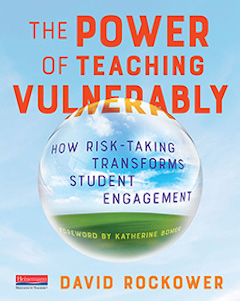The Power We Gain by Teaching Vulnerably
The Power of Teaching Vulnerably: How Risk-Taking Transforms Student Engagement
By David Rockower
(Heinemann, 2022 – Learn more)
Reviewed by Amy Estersohn

Rockower rehashes the stages of a lesson he knew worked well: he showed images of uniforms, asked students to move to one side of the classroom or another, students shared their thoughts, and eventually, students summarized their thoughts in writing.

Once Rockower became more comfortable with being more vulnerable with students and once students became more comfortable being vulnerable with each other, he felt more freedom to choose topics and situations that spoke to his students’ lived experiences.
He describes bringing in a story from The New York Times in which a Penn State football player receives a letter from a fan who criticized the player’s dreadlocks. Rockower, who teaches near the college, knew this story would appeal to his students and make them think about the interaction.
He describes how student conversation about the article bled into the next planned activity, and he realized he made an error when he wanted to cut the conversation short to move on. It’s what he writes next that demonstrates the crux of the book:
“I explained how, since our last conversation, I’d been thinking about how I’ve responded — or failed to respond — to racist remarks in my own life. I shared memories of relatives who’d made racist comments and how I was embarrassed to admit that I hadn’t always spoken up… We did agree that, even if it’s difficult, we must speak up. I suggested that the next time any of us hears a racially insensitive remark, we need to (at minimum) say, ‘Hearing that comment makes me uncomfortable’” (pg. 80)
Vulnerability: Personal, Relational, and Dialogic
Rockower demonstrates what he refers to as personal vulnerability when he shares his own story of failing to respond to injustice. For him, this is part of a culture he has built up with his students over the course of the year – writing next to them, sharing drafts with them, and sharing stories that help cultivate his humanity. He cautions that personal vulnerability does not mean sharing everything and it does mean establishing boundaries on what is shared.
He explains relational vulnerability as a willingness to listen to students without judgment and to cultivate the ability to apologize to a student without the “but” of defensiveness, e.g. “I’m sorry I yelled at you, but you were ignoring my directions.” Rockower demonstrates how he uses an apology to bridge a gap or to build community, as even in his anecdote above he apologizes to his class for cutting a conversation short.
Third, Rockower demonstrates dialogic vulnerability in his willingness to have a conversation about current events with his students and to bring a troubling situation that is local, relevant, and high-stakes into the classroom. He constantly asks students what they want to talk about and learn about and brings in materials that speak to these desires to converse.
Building a school culture around vulnerability
Perhaps the strongest piece of this book is its recommendations to school administrators about the work they can do to bring community together. These action items include
● Opportunity for “kudos” at the end of a faculty meeting where colleagues can compliment each other
● Hosting schoolwide or gradewide “showcases” or “identity presentations” in which students, faculty, or community members provide a brief presentation / demonstration of an interest or sharing a bit about an illness or personal challenge
● Inviting parents to share or participate in presentations.
What’s new? What’s relevant?
While this book brought up some important points about vulnerability in teaching and learning, I felt there were some missed opportunities.
First, the book relies heavily on excerpts from student reflections. While I find such excerpts interesting in small doses, the quantity and placement of the excerpts felt distracting to Rockower’s story. I would have appreciated more writing from Rockower instead of constant use of student excerpts.
Second, this book missed an opportunity to address teachers who fear losing their jobs if they bring discussions of race, class, and gender into the classroom. While these teachers may not be ready to be courageous and vulnerable with students, perhaps Rockower has other suggestions for them.
Amy Estersohn is a teacher and college admissions consultant. She runs a College Spotlight newsletter and can be reached at leadwithtalents@gmail.com.






























